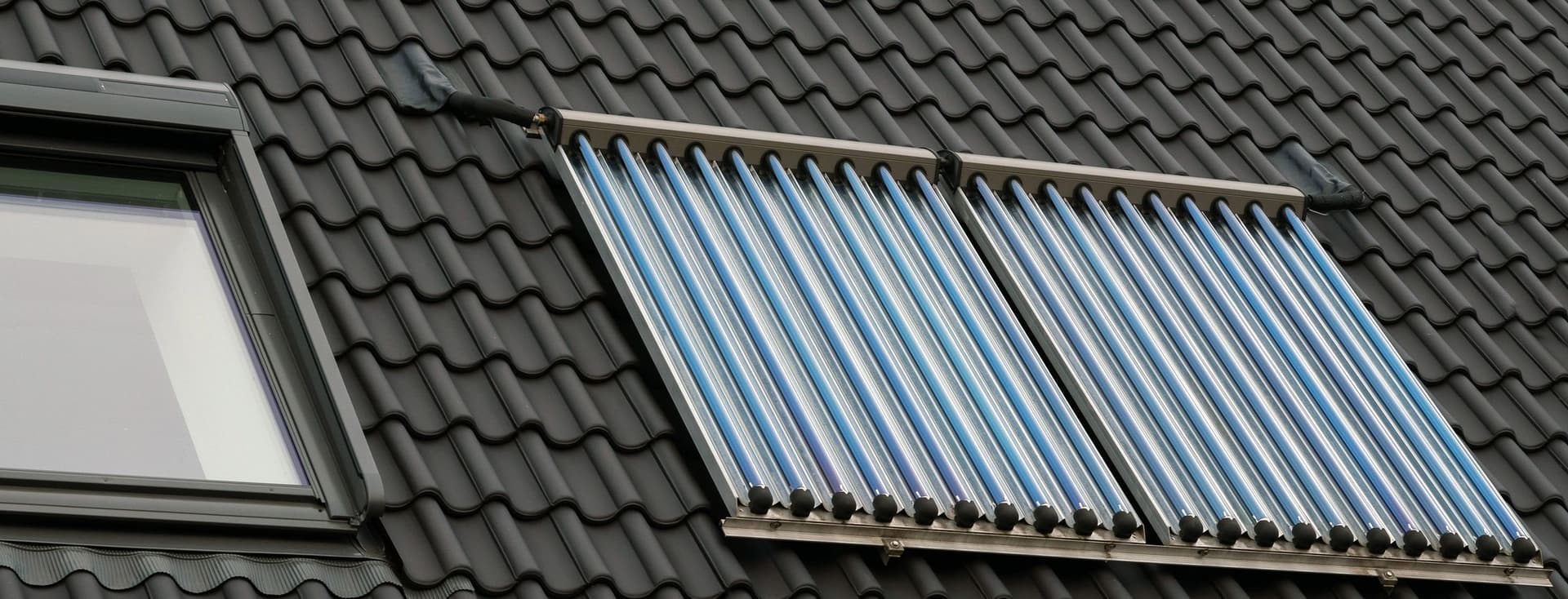
- 8 min read
- 24.06.2022
Retrofitting solar thermal energy in existing buildings

Retrofitting a solar thermal system can be environmentally friendly and also attractive from an economic point of view for property owners. Depending on the existing heating system and taking into account the local conditions, a solar thermal system actively supplements the heating or hot water supply. Due to rising energy costs, what has long been standard in new buildings also pays off when it comes to renovating old buildings. The state subsidises property owners with up to 35 per cent of the purchase price. Find out in our guide when it is feasible to retrofit a solar thermal system and what you need to consider before making the purchase.
Table of Content
What is solar thermal energy?
When is it worthwhile to retrofit a solar thermal system?
Technical configuration: Which kind of solar thermal system is best suited for the user?
What should be considered when choosing a solar thermal system?
What requirements must a property meet in order for it to be feasible to retrofit a solar thermal?
When is the right time to install a solar thermal system?
Solar thermal energy - a step towards a more self-sufficient future?
What is solar thermal energy?
Solar thermal energy is a system for generating heat with the help of solar energy. It usually consists of a solar collector on the roof, a hot water tank or a larger heating water tank and a pipe network with pump and solar controller. The function of a solar thermal system differs from that of a photovoltaic system. While the photovoltaic system converts the sun's rays into electricity and stores it in batteries, the solar thermal system uses a heat exchanger to heat water in the buffer tank to up to 95 degrees Celsius. This can be used to supply the bathroom and kitchen with hot water or as a backup heating system. The efficacy and costs of a solar thermal system depend on the following factors:
Type of collectors: Flat-plate collectors or vacuum tube collectors
Collector surface area: Tube collectors take up less space than flat-plate collectors
Size of the heat storage tank (number of persons, only for hot water or also as heating)
Pipe installation is usually more expensive when retrofitting than for new buildings
When is it worthwhile to retrofit a solar thermal system?
Due to the weather in Germany, most people use solar thermal as a hybrid heating system in combination with a second type of heating. This can be in a classic combination with a gas heating system. This is where solar thermal energy demonstrates its full potential. This is because it is precisely the heating systems that use fossil fuels that have the highest savings potential. While the prices for fossil fuels are constantly rising, solar energy will remain free in the future.
In combination with a pellet heating system or heat pump, solar thermal forms a so-called RE hybrid heating system. This refers to a combination of two types of heating based on renewable energies. The solar thermal system complements the already environmentally friendly heating system and provides even more independence from rising energy prices and the suppliers. In addition, the lower usage, especially in summer, reduces the burden on the existing heating system, which extends its operating life. If an aging heating system is becoming less efficient, retrofitting a solar thermal system can delay replacement for a long time. Not to mention the environmental aspect, because solar energy does not produce CO2. If the conditions for the collectors at the location are good to optimal, it is therefore almost always worthwhile to retrofit a solar thermal system.
Technical configuration: Which kind of solar thermal system is best suited for the user?
Typically, property owners use two different types of solar thermal systems. On the one hand, the solar system can be used exclusively to supply hot water in the house. The advantage of this is that the heating system remains switched off in summer. This reduces the burden on the heating system as well as your wallet. The solar thermal system heats the water with free solar energy. Furthermore, there are solar systems that also help with heating and are designed accordingly larger. There must be sufficient space on the roof for this, preferably in full sun.
Property owners can also choose between different collectors. Flat-plate collectors are standard and are very affordable. Alternatively, vacuum tube collectors are always the best choice when efficiency and space saving are important. The solar controller ensures optimum use of solar energy. If this is not sufficient, it switches on the conventional heating.
What should be considered when choosing a solar thermal system?
The costs for retrofitting a solar thermal system are higher for a heating backup system than for merely a hot water supply system. This is because a larger collector area and a large heating water storage tank are required. In addition, conversion work and pipe relocations may be required, which have a financial impact. In addition, renovators should also bear in mind that although solar energy is free, maintenance costs are still incurred for solar thermal systems. A pump needs electricity, the collectors and the controller need maintenance every now and then, and on top of that there are insurance expenses. Depending on the type of solar thermal system, the number of residents and their heating habits, and the orientation of the roof, the system pays for itself within 14 to 20 years on average. With the current development of rapidly rising energy prices and an annually increasing CO2 tax on fossil fuels, solar thermal energy to supplement oil or gas heating will probably pay off significantly faster in the future. The overview shows how large the collector area and the water storage tank should be and what the two types of solar thermal energy systems can cost:
Solar thermal for supplementary heating:
Size of the collectors: Collectors require an area of 1/10 of the living space to be heated (e.g. 150 sqm heated living space requires 15 sqm for collectors).
Size of the water storage tank: 40 to 50 litres per square metre of collector surface area
Savings potential: up to 30% of heating costs, in energy-efficient buildings even up to 50%.
Acquisition costs: between 8,000 and 12,000 euros
Solar thermal energy for hot water only:
Size of the collectors: Depending on the type of collectors, 1 to 1.5 sqm per person for hot water
Size of the water storage tank: 60 to 80 litres per person
Savings potential: up to 60% of the hot water demand on an annual average, 100% is possible in summer.
Acquisition costs: between 3,000 and 6,000 euros
What requirements must a property meet in order for it to be feasible to retrofit a solar thermal?
The intensity of the solar radiation is decisive for the efficiency of a solar thermal system. Therefore, the optimal orientation of the sunny roof surface is to the south, and without shading from trees or neighbouring buildings. In this way, solar collectors achieve their full potential, which can be 90 percent of the nominal capacity. If the roof faces west or east, this can already reduce exposure to the sun by up to 30 percent. A north-facing roof is at best sufficient for hot water supply in summer. Installation is relatively inexpensive if the pitch of the roof is between 30 and 50 degrees. On flat roofs, the collectors require an additional frame to achieve the correct tilt. This type of mounting can also be used for mono-pitch roofs whose pitch is too shallow. Supplementary heating systems should perform at full capacity, especially in winter. It is therefore advisable to mount the solar collectors with a tilt angle of 45 to 70 degrees. Since these solar systems have a higher potential, their output in summer is definitely sufficient to produce hot water. Especially in old buildings, it is important to ensure that the roof is in good condition and capable of bearing weight. If the collectors were to overload the roof, it would be necessary to renew the roof beforehand. In these cases, it is usually no longer feasible to retrofit a solar thermal system. The best prerequisites for retrofitting a solar thermal system are:
Shade-free roof area of sufficient size
Roof orientation to the south
Tilt angle for hot water 30 to 50 degrees, for heating 45 to 70 degrees
Pitched roof, otherwise with pitched mounting
Space in the house for a buffer tank of 300 to 1,000 litres
When is the right time to install a solar thermal system?
The best time to retrofit a solar thermal system is during the summer months. You can also do it in spring or autumn, as long as the temperatures are high enough. Since the solar thermal system has to be connected to the existing heating system, the installers temporarily switch off the heating and hot water supply. This would be unpleasant in cold winter temperatures. In addition, the roof should be free of snow and as dry as possible for the installation of the collectors. This reduces the time window for the possible installation of solar systems. Therefore, many heating companies have longer waiting times during the warmer months.
Solar thermal energy - a step towards a more self-sufficient future?
If the structural requirements are met, it is almost always worthwhile to retrofit a solar thermal system in an old or existing building. Whether for year-round hot water supply or to supplement the existing heating system in winter depends on the available roof area and the scope of the investment. The greater the demand for hot water or heating, the more viable a retrofitted solar thermal system will be. Solar thermal probably pays for itself most quickly when combined with a gas heating system. The CO2 tax on fossil fuels is set to rise year for year, significantly increasing energy costs. Added to this is the dependence on the world market and the fact that fossil energies are limited. Further price increases for natural gas will make solar thermal energy even more attractive in the future. Even in combination with a pellet heating system or a heat pump, solar energy, which is always free of charge, can still be worthwhile. It is the only energy source that is always equally available to everyone, regardless of politics or energy suppliers. This certainly makes solar thermal energy one of the most promising types of heating for the future.
You may also be interested in
 Apartment viewing: Guide for your successful viewing appointment
Apartment viewing: Guide for your successful viewing appointment Property Prices Greece: What Do Properties Cost in the Aegean?
Property Prices Greece: What Do Properties Cost in the Aegean?- 6 min.
- 18.08.2025
 Bungalow: Guide to your dream property
Bungalow: Guide to your dream property- 5 min.
- 29.10.2025
 Moving Checklist: Step-by-Step to a Successful Move
Moving Checklist: Step-by-Step to a Successful Move- 5 min.
- 12.11.2025
 Vacation Homes Mexico: Your dream property under the Mexican sun
Vacation Homes Mexico: Your dream property under the Mexican sun- 5 min.
- 23.09.2025
&w=1920&q=75) The US real estate market: Comprehensive guide for buyers
The US real estate market: Comprehensive guide for buyers&w=1920&q=75) Property prices Canada: Is buying real estate in Canada worth it?
Property prices Canada: Is buying real estate in Canada worth it? Successfully Find Apartments for Rent: Essential Apartment Search Tips
Successfully Find Apartments for Rent: Essential Apartment Search Tips
Contact
Contact your personal advisor


Engel & Völkers Germany
Vancouverstraße 2a
20457 Hamburg, Germany
Tel: +49 40 361310